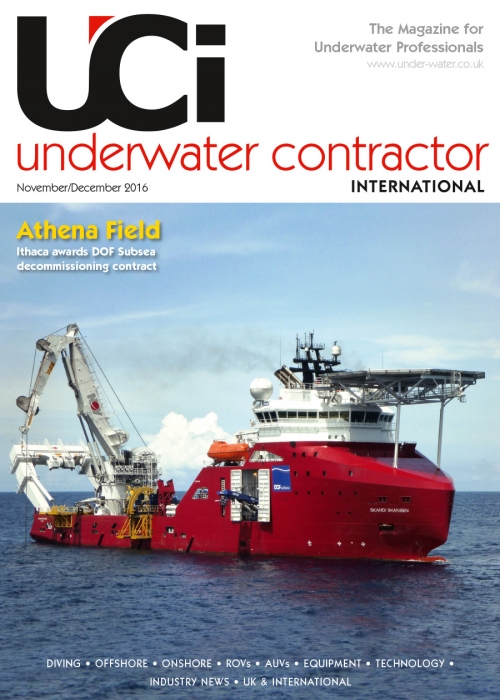
The Magazine for Underwater Professionals
![]() Sep/Oct 2015
Sep/Oct 2015
INDUSTRY NEWS - EQUIPMENT & TECHNOLOGY
OSIL increases core sampling length of giant piston corer
OSIL, UK, has announced it has increased the maximum core sampling length of its giant piston corer to 60 metres. The company said the move comes as a result of high demand from customers for the longer specification.
“We have seen considerable growth in interest in recent years for increasingly longer core samples, which has stemmed in part from the rising demand to explore and map deepwater subsea resources, and can only be achieved satisfactorily with a giant piston corer,” OSIL said.
The company added: “The giant piston corer is a rugged and reliable system, which can achieve 60-metre core samples in soft cohesive sediments and muds owing to its modular construction and integral piston, which reduces internal friction and prevents plugging.”
Nineteen partners from across Europe have come together to develop Europe’s first ultra-deepsea robot glider. The glider will be capable of sampling the ocean autonomously at depths of 5000 metres – and maybe more in the future – for up to three months at a time.
The project, which includes the National Oceanography Centre (NOC), UK, has won eight million euros (GB£5.6 million) of funding from the European Union’s Horizon2020 programme to develop and test the innovative new technology.
The capability of the new glider to reach at least 75% of the ocean will open up new possibilities for science and industry. These include monitoring submarine biodiversity and conducting environmental impact assessments for potential seabed mining and exploration.
For example, the new glider will be able to detect the of presence of plumes of sediment created by mining processes by using novel sensors developed by the NOC and housed in the nose of the glider. These plumes are an important element of the submarine ecosystem.
Dr Mario Brito, who is leading the project from the NOC, said “The development and integration of sensors that can work at these depths will be a real challenge…it is something that has not been done before and so the science behind it is really innovative. Furthermore, the range of sensors this glider can carry makes it well suited to a wide range of applications, both within research and industry.”
The US Navy has announced the first-of-class oceanographic research vessel Neil Armstrong (AGOR 27) has successfully completed its acceptance trials.
RV Neil Armstrong, the first of the Armstrong class oceanographic research ships, is a mono-hull vessel based on commercial design, capable of integrated, interdisciplinary, general purpose oceanographic research in coastal and deep-ocean areas.
The US Navy’s Board of Inspection and Survey (INSURV) found the ship to be well-built and inspection-ready. The trials evaluated the ship’s major systems and equipment to include demonstrations of the ship’s main propulsion system, dynamic positioning system, navigation, cranes and winches and communication systems.
“These trials are the final major milestone prior to delivering Neil Armstrong,” said Mike Kosar, programme manager for the Support Ships, Boats and Craft Office within the Program Executive Office, Ships. “Neil Armstrong performed very well during these trials, especially for a first-of-class vessel. The results of these tests and the outstanding fit, finish and quality of the vessel stand as a testament to the preparation and effort of our entire shipbuilding team. It reflects the exceptionalism of AGOR 27’s namesake, astronaut Neil Armstrong.”
Armstrong class AGORS are 72.5 metres long and will provide scientists with the tools and capabilities to support ongoing research in the Atlantic, western Pacific and Indian Ocean regions across a wide variety of missions.
RV Neil Armstrong will be operated by the Woods Hole Oceanographic Institution, USA, under a charter party agreement with the US Office of Naval Research. The vessel will operate with a crew of 20 with accommodation for 24 scientists.
Canadian and British researchers will join forces to collaborate on two projects in developing new sensing technologies for tidal energy applications. The two projects, with a combined value of CA$1.43 million (GB£705,000), were selected for funding through a joint research competition managed and funded by the Offshore Energy Research Association, a Nova Scotia, Canada-based not-for-profit research group, and Innovate UK, a government funded UK business and innovation accelerator.
The two project teams each feature industry and academic expertise from Canada and the UK. Each will introduce new environmental monitoring and measurement sensor systems with a goal to reduce risk and uncertainties associated with the deployment and operation of in-stream tidal devices. Sensor deployment and testing will be carried out in both Canadian and UK waters.
The first project is led by Nova Scotia-based Emera Inc. in partnership with OpenHydro Canada, Ocean Sonics, Canada, and Acadia University, Canada, along with UK-based Tritech and the UK and Canadian operations of SMRU (Sea Mammal Research Unit) Consulting. The project will deliver a system using both passive and active acoustic sensor technologies. A data interface will be created allowing data from each sensor to be integrated into a fish and marine mammal data set. The system will improve the ‘real-time’ detection and tracking of fish and marine mammals at tidal sites in the Bay of Fundy, Canada. Specifically, testing will be done at the Cape Sharp Tidal berth at the Fundy Ocean Research Centre for Energy (FORCE) site.
IMPACT
The second project is led by British Columbia, Canada-based Rockland Scientific, in partnership with Dalhousie University, Canada, and Black Rock Tidal, Canada, along with UK-based FloWave TT, the European Marine Energy Centre and Ocean Array Systems. Rockland Scientific and its partners will develop a new sensor system to measure the impact of turbulence on tidal devices. Project results will be used to improve turbine designs and operation performance, as well as assessment of installation sites.
The developed turbulence sensor systems will be tested and installed at three locations. First at the FloWaveTT Energy Research Facility in Edinburgh to test and validate the laboratory configuration. Deployments will then be carried out at the European Marine Energy Centre in Orkney and at the FORCE site in the Bay of Fundy. The data sets from all measurement locations will be compared against each other and theoretically analysed for turbulence flow structure.
Great Yarmouth, UK-based Applied Acoustic Engineering (AAE) has introduced a new transponder designed for use by subsea unexploded ordnance disposal organisations and salvage specialists.
The company said it has developed the product, named the 1439 Blowfish ODT, as a combined positioning transponder and triggering device. “It provides the twin functions of confirming a safe distance from a target, and receiving and acting upon a specific acoustic signal. It can be used to trigger a detonator, actuate a hydraulic valve or inflate a lift bag, for example,” it said.
The Blowfish ODT transponder can operate in up to 1000 metres of water, can be configured using AAE’s 3510 PAM Portable and operate as a ranging and positioning beacon with the company’s Easytrak Nexus USBL system. “The small beacon, with a battery life of 180 days, is less than 320 millimetres in length, weighs just 850 grams but is extremely robust,” said AAE.
The company added that in addition to detonator initiation and secure remote actuation, the transponder can also be used for metocean or ocean bottom seismic equipment positioning and recovery.
Kraken Sonar, Canada, has announced the development of KATFISH (Kraken Active Towfish), an innovative sonar platform for military and commercial applications.
“The primary objective of the KATFISH project is to develop an actively controlled, intelligent towfish as a platform for real-time, ultra-high-resolution seabed mapping system, based on Kraken’s miniature interferometric synthetic aperture sonar (MINSAS) technology and real-time SAS processing algorithms,” said a spokesman.
The KATFISH system is comprised of an actively controlled smart towfish, winch and handling subsystem and operator console. The winch and handling subsystem provides the capability to launch, tow, recover and stow the towfish. The entire system is designed to be quickly installed and removed from craft of opportunity platforms and is packaged for easy transportation.
“Conventional sidescan systems are limited in that they only provide high-resolution imagery at short range,” explained the spokesman. “KATFISH produces ultra-high-resolution seabed imagery with constant resolution to full range. The additional information provided by KATFISH delivers a detection and classification capability that cannot be achieved with a conventional sidescan sonar.”
The spokesman said KATFISH also generates highly accurate bathymetry data that is co-registered and geo-referenced to the same pixel grid co-ordinates as the imagery. Operators can produce crisp seabed imagery and detailed 3D digital terrain maps of seafloor topography that exceed IHO SP-44 survey standards, he said.


